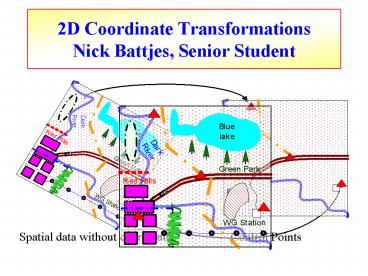2D Coordinate Transformations Nick Battjes, Senior Student - PowerPoint PPT Presentation
1 / 33
Title:
2D Coordinate Transformations Nick Battjes, Senior Student
Description:
Integrating of maps and spatial data in local ... Isogonal: having equal angles ... Isogonal Affine Transformation. or Conformal/Similarity Transformation ... – PowerPoint PPT presentation
Number of Views:165
Avg rating:3.0/5.0
Title: 2D Coordinate Transformations Nick Battjes, Senior Student
1
2D Coordinate TransformationsNick Battjes,
Senior Student
Spatial data without coordinates
Control Points
2
Applications
- Integrating of maps and spatial data in local
coordinate system into a world database system. - Note how the vector data (USGS Road layer) should
be transformed to match the raster data (Ikonos 1
meter res. Image)
3
2D Spatial Transformations
- Three different transformation primitives for
the Similarity transformation - Translation- origin is moved, axes do not rotate
i.e. - Xn X0 DX0 Yn Y0 DY0
- Scaling - both origin and axes are fixed, scale
change - Xn sX X0 Yn sY Y0
- Rotation - origin fixed, axes move (rotate about
origin) - Xn X0 cos(?) Y0 sin(?) Yn - X0
sin(?) Y0 cos(?)
4
Two-DimensionalGeographic Transformations
Scaling
Rotation
Translation
5
Conformal Transformation
- Moves and rotates objects in 2D and 3D space.
Additionally, you can scale the objects based on
alignment points when using the 2D option.
6
Isogonal Affine Transformationor
Conformal/Similarity Transformation
- Isogonal having equal angles
- Impose additional condition of equal scale (S
Cx Cy) yielding 4 parameters S, ?, DX0, DY0 - Moves and rotates and scale objects in 2D space.
4 parameters S scale, a rotation, DX0, DY0
shifts in X and Y. Xn,Yn are the transformed
coordinates. Xo, Yo are the original
coordinates. Two given points are required (
X1,Y1 and X2,Y2)
7
Conformal Transformation
- Moves and rotates and scale objects in 2D space.
- Often called similarity Transformation since the
basic shape remain similar after the
transformation
8
Conformal Transformation
- The formulas can be written in different forms
- To compute the parameters given the coordinates
- To compute the new coordinates given the
parameters
9
Conformal/Similarity Transformation
- The formulas can be written in different forms
- 3. To compute the old coordinates given the
parameters and new coordinates (back
substitution)
The same operation to obtain Y0
10
Conformal Transformation Example
- Moves, rotates and scale objects in 2D space.
11
Conformal Transformation Example
- Transform a given point X0121.48, Y022.78
- The point is transformed to Xn310.59,
Yn373.6773
12
Affine Transformation
- Used in photogrammetry for
- Transform comparator coordinates to photo
coordinates and used for correcting film
distortion - Transform model coordinates to survey coordinates
- Property
- Carry parallel lines
- into parallel lines
- Does not have to
- preserve orthogonality
13
Affine Transformation
Physical interpretation 6 parameters Cx, Cy,
?, ?, Dx0, Dy0, and in linear form
14
2-D Affine Transformation
- The formulas for an affine transformation
- If n control points are measured, this Equation
is reorganized as follows
15
Projective or Polynomial Transformation
- Instead of 4 or 6 parameters we have many
parameters at least 8 (8 would be the Bi-linear
or projective transformation) - With more parameters we need more known points to
solve the equations - N-equations and N unknowns.
16
Polynomial Transformation
- General form
- Alternatively,
17
Projective Transformation
- Frequently used in photogrammetry
- General form
18
Orthogonal Affine Transformation
- Impose condition of orthogonality (? 0)
yielding 5 parameters Cx, Cy, ?, ?x, ?y
19
Rigid Body Transformation
- Condition orthogonality and no scale change (Cx
Cy 1) - 3 parameters ?, ?x, ?y
20
Least Squares Adjustment Review
- Model of adjustment of indirect observation (
Gauss-Markov model) - n of observations
- m of parameters
- f is a vector of given observation
- V is the vector of residuals
- B is the matrix of coefficients
- W it the matrix of weights (Variance
Covariance matrix) - ?0 is the reference variance
- ? is the vectors of parameters to be
estimated - Number of observation is larger than number of
parameters (redundant observations). The solution
that minimize the least-squares criterion (vTwv)
is
21
General 2D Conformal Transformation, Example
- Four fiducial marks (1 - 4) and two image points
(a and b) were measured on a comparator. The
comparator photo observations and the known
values from the camera calibration report are
given in the following spreadsheet.
22
General 2D Conformal Transformation, Example
23
General 2D Conformal Transformation, Example
24
General 2D Conformal Transformation, Example
25
General 2D Conformal Transformation, Example
26
General 2D Affine Transformation
- Normally shown as
- Unique solution if
27
General 2D Affine Transformation, Example
- Four fiducial marks (1 - 4) and two image points
(a and b) were measured on a comparator. The
comparator photo observations and the known
values from the camera calibration report are
given in the following spreadsheet.
28
General Affine Transformation, Example
29
General Affine Transformation, Example
Solution forming the B matrix and f vector
30
General Affine Transformation, Example
31
General Affine Transformation, Example
32
General Affine Transformation, Example
33
General Affine Transformation, Example































